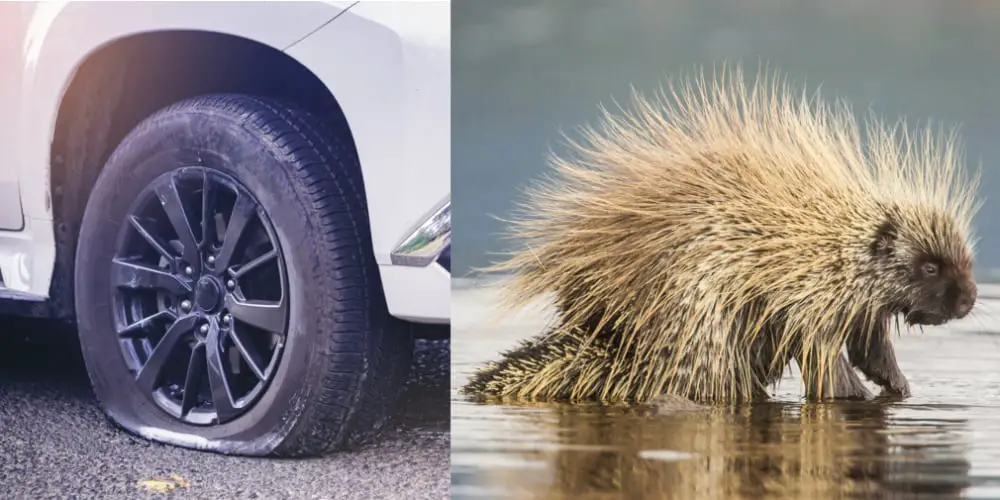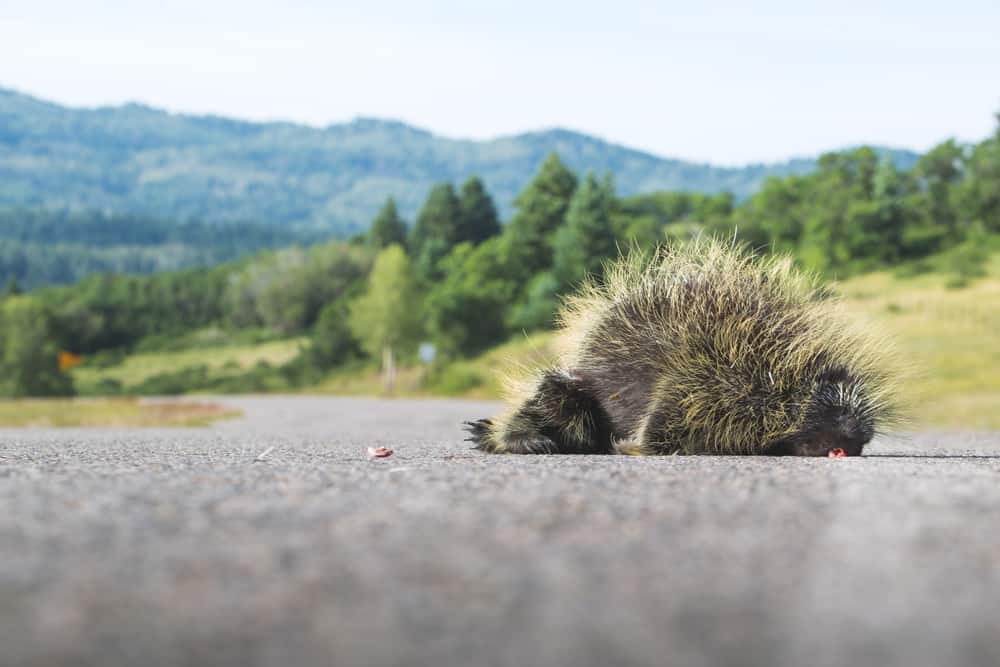
I don’t know anyone alive who enjoys getting a flat tire. And, like adding salt to a wound, there are nearly countless sources of flat tires. Some are pretty weird, and some are common. But what about porcupines?
Have you ever wondered if they can be added to the list of potential flat tires? Well, I wondered, and here’s what I found.
Although flat tires from porcupines are uncommon, they are entirely possible and, in fact, do occur from time to time. However, it does require some specific conditions, like a worn tire and hitting the porcupine in such a way that the quill punctures the side wall.
Fortunately, if you know the conditions to get a puncture from a porcupine, you have all the tools you need to try and prevent it from happening.
It’s also important to know that not all porcupines are created equal. Some have longer quills, increasing the destructive potential.
How Can Porcupines Cause Flat Tires?
Let’s get one fact out of the way first. Contrary to what Looney Toons taught us, porcupines don’t shoot their quills, but they do detach upon contact as a defense mechanism.
So, if you are worried about a porcupine strolling into your garage and shooting your tire full of quills, you can rest easy.
Punctures Are Typically Caused By Running Them Over
It should be obvious, but the only way for you to get a puncture from a porcupine is from your tire connecting with the poor creature’s quills with a decent amount of force. In other words, these punctures can only really happen if you run one over.
An average North American porcupine has around 30’000 quills. And when a porcupine is struck, many of those quills will release. This vastly increases your odds of getting a flat tire.
Quills Are Not As Strong As Tires
But I know many people who have struck a porcupine and walked away without a flat tire. This is because car tires are made really strong, as you would hope. Porcupine quills, on the other hand, are hollow.
So, although the quills are sharp, they can be bent easily. This is especially true if they are bent by the weight of a Ford F150. However, they can be surprisingly strong if force is applied directly down the length of the quill.
In other words, you would need to strike a quill at the right angle. Otherwise, the quill would bend out of the way.
The best chance of this happening is if the porcupine goes into defense mode at the last moment. When a porcupine is threatened, it raises its quills in the direction of that threat. In this form, the porcupine becomes a nail-covered puncture machine.
New Tires Have Some Puncture-Defense Measures
Even if you run over a porcupine in defense mode, there is still a good chance you won’t get a flat.
Have you ever driven over a nail and not noticed for a few weeks? I have. Many times, in fact. I usually only notice when that tire consistently needs to be inflated slightly every few days.
Modern tires are designed to be good at dealing with minor punctures. And, as long as the object remains in place, air leakage is minimal. In other words, you could hit a porcupine, have a quill puncture deep into your tire through the tread, and never know about it.
However, even modern tires have a weakness: their sidewalls. The sidewalls aren’t nearly as good at sealing up holes as the tread. So, the best chance to get a flat tire from a porcupine is if one of the quills punches through your side wall and then becomes dislodged as drive.
That being said, all of the tire’s strengths are meaningless if you drive around on old, worn-out tires. Old tires have worn outer treads and weaker structures.
You won’t get away with that nail in an old tire. Likewise, you probably won’t get away with a porcupine quill in an old tire, either.
Some Porcupines Are More Dangerous Than Others
Did you know that there are several types and sub-types of porcupine around the world? The kind of porcupine you get in your area directly affects the likelihood of getting a flat tire if you run one over.
For example, the typical North-American porcupine is around two feet long, weighs 20 pounds, and has two to three inches long quills. Therefore, getting a flat tire from this porcupine requires all of the above conditions to be in place.
On the other hand, the South African Cape porcupine is the biggest in the world. They can weigh up to 66 pounds, and their quills are a staggering 11 to 20 inches long.
From experience, I can tell you that a flat tire is the least of your worries if you run these bad boys over. Trucks generally need new bumpers after a collision. But, if you hit one with a car, you will likely need to scrape the remains of your radiator off your back seat.
How To Avoid Porcupine Flats

Fortunately, there are some ways to further minimize your odds of getting a quill piercing in your tire.
The first and most important is to avoid driving on worn-out tires. This is a generally good life principle, but it also applies here. Worn tires vastly increase your odds of getting a flat from a quill, so keep your tires fresh.
Secondly, porcupines are nocturnal. If you are really concerned, then avoid rural roads at night. If you can’t avoid them, you must be extra vigilant as you cruise along. Unfortunately, porcupines are also quite dark making them difficult to spot on a dark tarmac at night.
A final tip is that you must refrain from swerving. As I have said, getting a flat is uncommon, so if you find yourself on an inevitable collision course with a porcupine, don’t swerve. Instead, grit your teeth and take the hit.
During a swerve, you risk losing control of the car, running off the road, or running into oncoming traffic. All of these will do considerably more damage to your vehicle and body than a few quills.
Conclusion
Although it is possible to get a flat tire from running over a porcupine, it is rare. Tires are much stronger than porcupine quills, and punctures through the tread of the tire don’t always end in flats.
So a quill will need to pierce the tire’s sidewall and then become dislodged, allowing the air to escape quickly.
